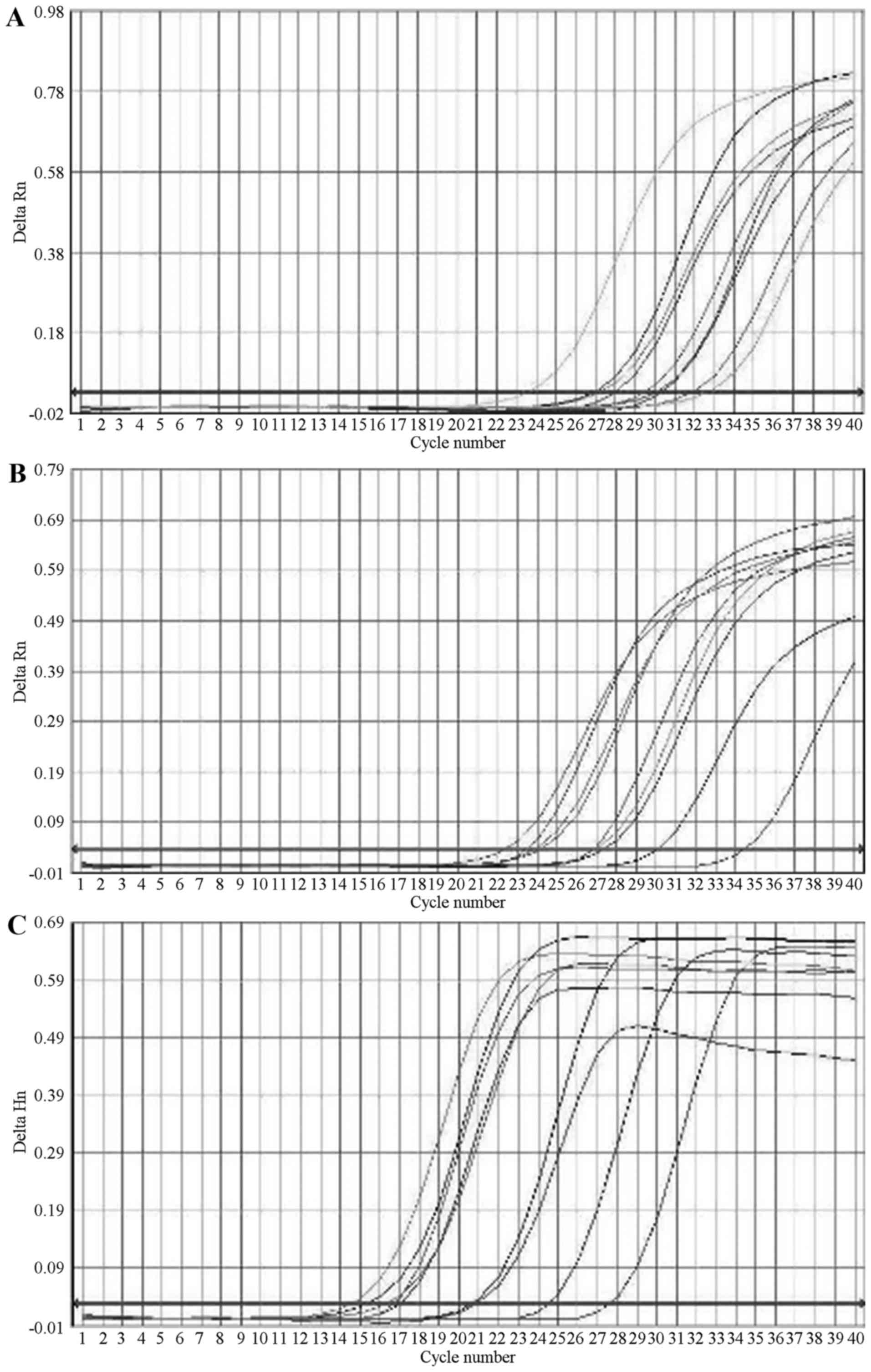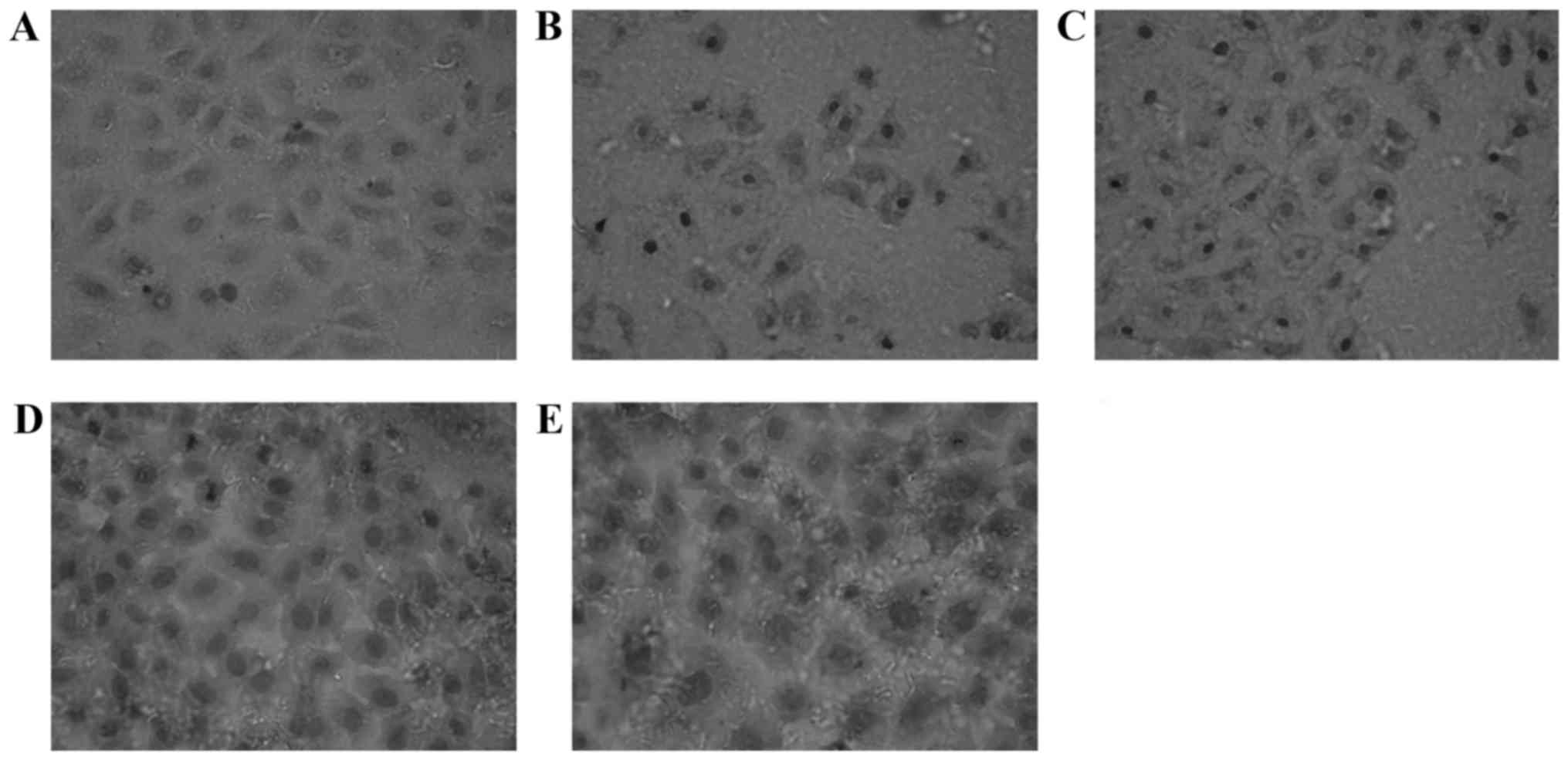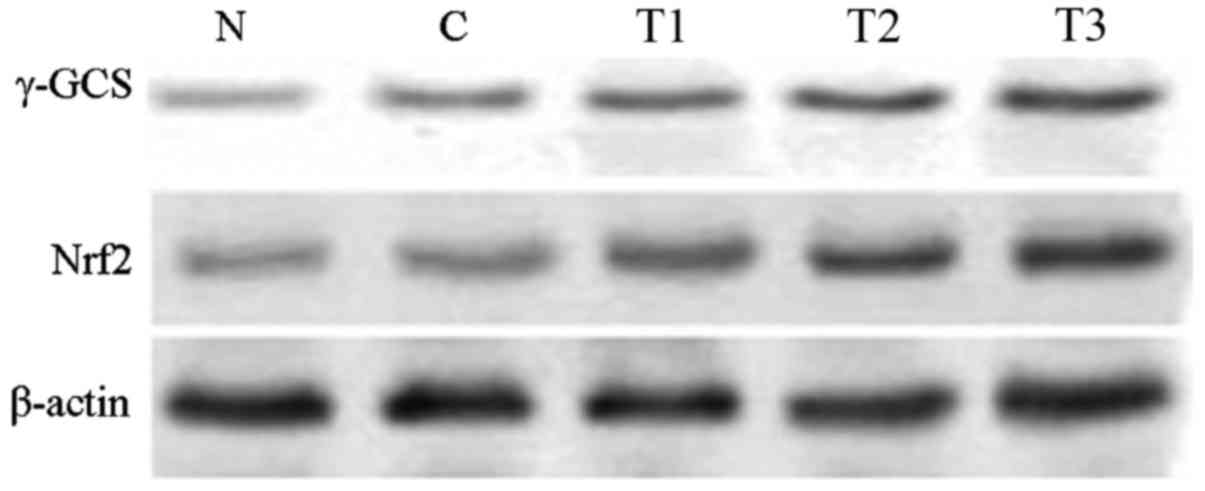|
1
|
Rani V, Deep G, Singh RK, Palle K and
Yadav UC: Oxidative stress and metabolic disorders: Pathogenesis
and therapeutic strategies. Life Sci. 148:183–193. 2016. View Article : Google Scholar : PubMed/NCBI
|
|
2
|
Tamay-Cach F, Quintana-Pérez JC,
Trujillo-Ferrara JG, Cuevas-Hernández RI, Del Valle-Mondragón L,
García-Trejo EM and Arellano-Mendoza MG: A review of the impact of
oxidative stress and some antioxidant therapies on renal damage.
Ren Fail. 38:171–175. 2016. View Article : Google Scholar : PubMed/NCBI
|
|
3
|
Lindblom R, Higgins G, Coughlan M and de
Haan JB: Targeting mitochondria and reactive oxygen species-driven
pathogenesis in diabetic nephropathy. Rev Diabet Stud. 12:134–156.
2015. View Article : Google Scholar : PubMed/NCBI
|
|
4
|
Cervellati F, Cervellati C, Romani A,
Cremonini E, Sticozzi C, Belmonte G, Pessina F and Valacchi G:
Hypoxia induces cell damage via oxidative stress in retinal
epithelial cells. Free Radic Res. 48:303–312. 2014. View Article : Google Scholar : PubMed/NCBI
|
|
5
|
Costa JG, Saraiva N, Guerreiro PS, Louro
H, Silva MJ, Miranda JP, Castro M, Batinic-Haberle I, Fernandes AS
and Oliveira NG: Ochratoxin A-induced cytotoxicity, genotoxicity
and reactive oxygen species in kidney cells: An integrative
approach of complementary endpoints. Food Chem Toxicol. 87:65–76.
2016. View Article : Google Scholar : PubMed/NCBI
|
|
6
|
Choi K, Ortega MT, Jeffery B, Riviere JE
and Monteiro-Riviere NA: Oxidative stress response in canine in
vitro liver, kidney and intestinal models with seven potential
dietary ingredients. Toxicol Lett. 241:49–59. 2016. View Article : Google Scholar : PubMed/NCBI
|
|
7
|
Cho YE, Kim HS, Lai C, Stanfill A and
Cashion A: Oxidative stress is associated with weight gain in
recipients at 12-months following kidney transplantation. Clin
Biochem. 49:237–242. 2016. View Article : Google Scholar : PubMed/NCBI
|
|
8
|
Liu Y, Qiu J, Wang Z, You W, Wu L, Ji C
and Chen G: Dimethylfumarate alleviates early brain injury and
secondary cognitive deficits after experimental subarachnoid
hemorrhage via activation of Keap1-Nrf2-ARE system. J Neurosurg.
123:915–923. 2015. View Article : Google Scholar : PubMed/NCBI
|
|
9
|
Tanaka Y, Kume S, Araki H, Nakazawa J,
Chin-Kanasaki M, Araki S, Nakagawa F, Koya D, Haneda M, Maegawa H
and Uzu T: 1-Methylnicotinamide ameliorates lipotoxicity-induced
oxidative stress and cell death in kidney proximal tubular cells.
Free Radic Biol Med. 89:831–841. 2015. View Article : Google Scholar : PubMed/NCBI
|
|
10
|
Andrich K and Bieschke J: The Effect of
(−)-Epigallo-catechin-(3)-gallate on amyloidogenic proteins
suggests a common mechanism. Adv Exp Med Biol. 863:139–161. 2015.
View Article : Google Scholar : PubMed/NCBI
|
|
11
|
Navarro E, Serrano-Heras G, Castaño MJ and
Solera J: Real-time PCR detection chemistry. Clin Chim Acta.
439:231–250. 2015. View Article : Google Scholar : PubMed/NCBI
|
|
12
|
Soung HS, Wang MH, Tseng HC, Fanga HW and
Chang KC: (−)Epigallocatechin-3-gallate decreases the
stress-induced impairment of learning and memory in rats. Neurosci
Lett. 602:27–32. 2015. View Article : Google Scholar : PubMed/NCBI
|
|
13
|
Cai S, Zhong Y, Li Y, Huang J, Zhang J,
Luo G and Liu Z: Blockade of the formation of insoluble
ubiquitinated protein aggregates by EGCG3′ Me in the
alloxan-induced diabetic kidney. PLoS One. 8:e756872013. View Article : Google Scholar : PubMed/NCBI
|
|
14
|
Hyung SJ, DeToma AS, Brender JR, Lee S,
Vivekanandan S, Kochi A, Choi JS, Ramamoorthy A, Ruotolo BT and Lim
MH: Insights into antiamyloidogenic properties of the green tea
extract (−)-epigallocatechin-3-gallate toward metal-associated
amyloid-β species. Proc Natl Acad Sci USA. 110:3743–3748. 2013.
View Article : Google Scholar : PubMed/NCBI
|
|
15
|
Wang Y, Liu N, Bian X, Sun G, Du F, Wang
B, Su X and Li D: Epigallocatechin-3-gallate reduces tubular cell
apoptosis in mice with ureteral obstruction. J Surg Res.
197:145–154. 2015. View Article : Google Scholar : PubMed/NCBI
|
|
16
|
Zhao CG, Zhou P and Wu YB: Impact and
significance of EGCG on Smad, ERK, and β-catenin pathways in
transdifferentiation of renal tubular epithelial cells. Genet Mol
Res. 14:2551–2560. 2015. View Article : Google Scholar : PubMed/NCBI
|
|
17
|
Tao L, Forester SC and Lambert JD: The
role of the mitochondrial oxidative stress in the cytotoxic effects
of the green tea catechin, (−)-epigallocatechin-3-gallate, in oral
cells. Mol Nutr Food Res. 58:665–676. 2014. View Article : Google Scholar : PubMed/NCBI
|
|
18
|
Zhong RZ, Fang Y, Qin GX, Li HY and Zhou
DW: Tea catechins protect goat skeletal muscle against
H2O2-induced oxidative stress by modulating
expression of phase 2 antioxidant enzymes. J Agric Food Chem.
63:7921–7928. 2015. View Article : Google Scholar : PubMed/NCBI
|
|
19
|
Zhai W, Zheng J, Yao X, Peng B, Liu M,
Huang J, Wang G and Xu Y: Catechin prevents the calcium oxalate
monohydrate induced renal calcium crystallization in NRK-52E cells
and the ethylene glycol induced renal stone formation in rat. BMC
Complement Altern Med. 13:2282013. View Article : Google Scholar : PubMed/NCBI
|
|
20
|
Ding X, Wang D, Li L and Ma H:
Dehydroepiandrosterone ameliorates
H2O2-induced Leydig cells oxidation damage
and apoptosis through inhibition of ROS production and activation
of PI3K/Akt pathways. Int J Biochem Cell Biol. 70:126–139. 2016.
View Article : Google Scholar : PubMed/NCBI
|
|
21
|
Schultz MA, Abdel-Mageed AB and Mondal D:
The Nrf1 and Nrf2 balance in oxidative stress regulation and
androgen signaling in prostate cancer cells. Cancers (Basel).
2:1354–1378. 2010. View Article : Google Scholar : PubMed/NCBI
|
|
22
|
Furnari MA, Saw CL, Kong AN and Wagner GC:
Altered behavioral development in Nrf2 knockout mice following
early postnatal exposure to valproic acid. Brain Res Bul.
109:132–142. 2014. View Article : Google Scholar
|
|
23
|
Khoi PN, Park JS, Kim JH, Xia Y, Kim NH,
Kim KK and Jung YD: (−)-Epigallocatechin-3-gallate blocks
nicotine-induced matrix metalloproteinase-9 expression and
invasiveness via suppression of NF-κB and AP-1 in endothelial
cells. Int J Oncol. 43:868–876. 2013. View Article : Google Scholar : PubMed/NCBI
|
|
24
|
Park SY, Jeong YJ, Kim SH, Jung JY and Kim
WJ: Epigallocatechin gallate protects against nitric oxide-induced
apoptosis via scavenging ROS and modulating the Bcl-2 family in
human dental pulp cells. J Toxicol Sci. 38:371–378. 2013.
View Article : Google Scholar : PubMed/NCBI
|
|
25
|
Feng B, Fang Y and Wei SM: Effect and
mechanism of epigallocatechin-3-gallate (EGCG). against the
hydrogen peroxide-induced oxidative damage in human dermal
fibroblasts. J Cosmet Sci. 64:35–44. 2013.PubMed/NCBI
|
|
26
|
Toniolo A, Buccellati C, Pinna C, Gaion
RM, Sala A and Bolego C: Cyclooxygenase-1 and prostacyclin
production by endothelial cells in the presence of mild oxidative
stress. PLoS One. 8:e566832013. View Article : Google Scholar : PubMed/NCBI
|
|
27
|
Deshmukh P, Unni S, Krishnappa G and
Padmanabhan B: The Keap1–Nrf2 pathway: Promising therapeutic target
to counteract ROS-mediated damage in cancers and neurodegenerative
diseases. Biophys Rev. 9:41–56. 2017. View Article : Google Scholar : PubMed/NCBI
|
|
28
|
Magesh S, Chen Y and Hu L: Small molecule
modulators of Keap1-Nrf2-ARE pathway as potential preventive and
therapeutic agents. Med Res Rev. 32:687–726. 2012. View Article : Google Scholar : PubMed/NCBI
|
|
29
|
Mitsuishi Y, Motohashi H and Yamamoto M:
The Keap1–Nrf2 system in cancers: Stress response and anabolic
metabolism. Front Oncol. 2:2002012. View Article : Google Scholar : PubMed/NCBI
|
|
30
|
Sandberg M, Patil J, D'Angelo B, Weber SG
and Mallard C: NRF2-regulation in brain health and disease:
Implication of cerebral inflammation. Neuropharmacology.
79:298–306. 2014. View Article : Google Scholar : PubMed/NCBI
|
|
31
|
Tebay LE, Robertson H, Durant ST, Vitale
SR, Penning TM, Dinkova-Kostova AT and Hayes JD: Mechanisms of
activation of the transcription factor Nrf2 by redox stressors,
nutrient cues, and energy status and the pathways through which it
attenuates degenerative disease. Free Radic Biol Med. 88:108–146.
2015. View Article : Google Scholar : PubMed/NCBI
|
|
32
|
O'Brien S and Kay NE: Maintenance therapy
for B-chronic lymphocytic leukemia. Clin Adv Hematol Oncol.
9:22–31. 2011.PubMed/NCBI
|
|
33
|
Muthusamy VR, Kannan S, Sadhaasivam K,
Gounder SS, Davidson CJ, Boeheme C, Hoidal JR, Wang L and
Rajasekaran NS: Acute exercise stress activates Nrf2/ARE signaling
and promotes antioxidant mechanisms in the myocardium. Free Radic
Biol Med. 52:366–376. 2012. View Article : Google Scholar : PubMed/NCBI
|
|
34
|
Ma Q: Role of Nrf2 in oxidative stress and
toxicity. Annu Rev Pharmacol Toxicol. 53:401–426. 2013. View Article : Google Scholar : PubMed/NCBI
|














